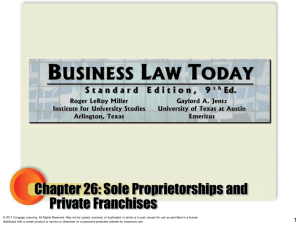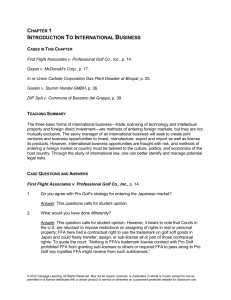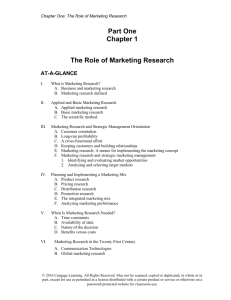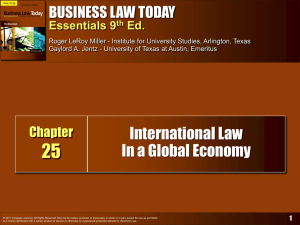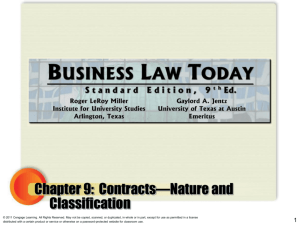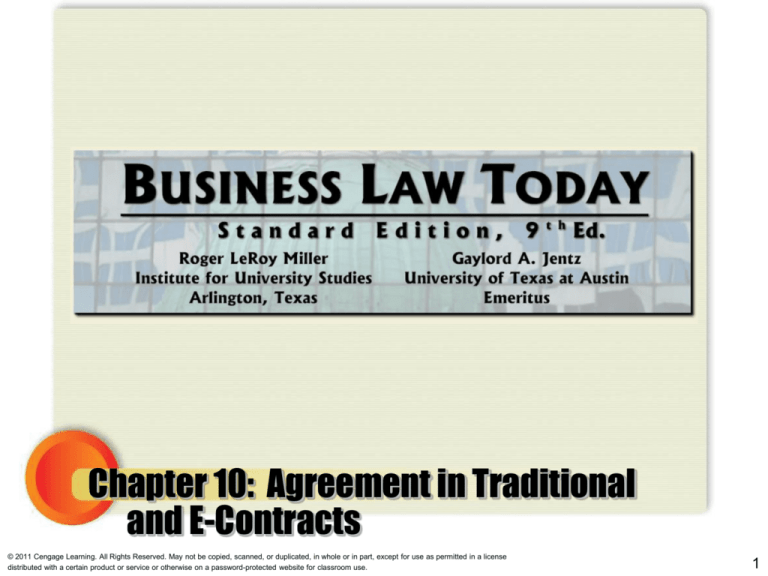
Chapter 10: Agreement in Traditional
and E-Contracts
© 2011 Cengage Learning. All Rights Reserved. May not be copied, scanned, or duplicated, in whole or in part, except for use as permitted in a license
distributed with a certain product or service or otherwise on a password-protected website for classroom use.
1
Learning Objectives
• What elements are necessary for an effective
offer? What are some examples of nonoffers?
• In what circumstances will an offer be
irrevocable?
• What are the elements that are necessary for an
effective acceptance?
• How do shrink-wrap and click-on agreements
differ from other contracts? How have traditional
laws been applied to these agreements?
• What is the Uniform Electronic Transactions
Act? What are some of the major provisions of
this act?
© 2011 Cengage Learning. All Rights Reserved. May not be copied, scanned, or duplicated, in whole or in part, except for use as permitted in
a license distributed with a certain product or service or otherwise on a password-protected website for classroom use.
2
Requirements of the Offer
• An agreement consists of a valid offer
and acceptance.
• An offer is the Offeror’s promise to
perform.
• An offer requires:
– (1) Serious, objective intention.
Case 10.1 Lucy v. Zehmer.
Although the parties had been drinking, the court found
the circumstanced indicated a serious offer, acceptance
and consideration, and a writing.
© 2011 Cengage Learning. All Rights Reserved. May not be copied, scanned, or duplicated, in whole or in part, except for use as permitted in
a license distributed with a certain product or service or otherwise on a password-protected website for classroom use.
3
Requirements of an Offer
• An offer requires (continued):
– (1) Serious Intention:
•
•
•
•
Expressions of Opinions are not offers.
Statements of Future Intent are not offers.
Preliminary Negotiations are not offers.
Advertisements, Catalog, and Circulars are not
offers.
• Auctions are not offers.
• Agreements to Agree are not offers.
Case 10.2 Basis Technology Corp. v.
Amazon.com, Inc.
Agreement entered into via emails was a binding settlement
agreement that was complete and unambiguous.
© 2011 Cengage Learning. All Rights Reserved. May not be copied, scanned, or duplicated, in whole or in part, except for use as permitted in
a license distributed with a certain product or service or otherwise on a password-protected website for classroom use.
4
Requirements of an Offer
• An offer requires (continued):
– (2) Definiteness: Reasonably definite terms
so that a court can determine whether a
breach has occurred and give an appropriate
remedy.
– (3) Communication of Offer to Offeree.
© 2011 Cengage Learning. All Rights Reserved. May not be copied, scanned, or duplicated, in whole or in part, except for use as permitted in
a license distributed with a certain product or service or otherwise on a password-protected website for classroom use.
5
Termination of the Offer By
Act of the Parties
• Revocation of the Offer (by Offeree) is
possible if communicated to Offeree
before the offer is accepted.
– Exception: Irrevocable Offers, based on
detrimental reliance or promissory
estoppel, cannot be revoked.
– Option Contracts: requires consideration.
Case 10.3 T.W. Nickerson, Inc. v. Fleet
National Bank.
Optionee, with right of first refusal, must be notified of “any
bona fide offer” to sell the property for consideration.
© 2011 Cengage Learning. All Rights Reserved. May not be copied, scanned, or duplicated, in whole or in part, except for use as permitted in
a license distributed with a certain product or service or otherwise on a password-protected website for classroom use.
6
Termination of the Offer By
Act of the Parties
• Rejection of the Offer by the Offeree.
– Effective only when actually received by the
Offeror or its agent.
• Counter Offer by the Offeree.
– Rejection of original offer and simultaneous
making new offer with different, material
terms. Original Offeror can accept.
– “Mirror Image” Rule: at common law, material
terms must be identical or rejection.
© 2011 Cengage Learning. All Rights Reserved. May not be copied, scanned, or duplicated, in whole or in part, except for use as permitted in
a license distributed with a certain product or service or otherwise on a password-protected website for classroom use.
7
Termination of the Offer By
Operation of Law
• Lapse of Time.
– Offer automatically terminates by law based on
terms specified in the offer itself.
• Destruction of Subject Matter.
– Offer automatically terminates if subject matter
destroyed before offer accepted.
• Death or Incompetence of either party.
– Unless offer is irrevocable.
• Supervening Illegality of Proposed Contract.
– Statute or court decision making the offer illegal
automatically terminates it.
© 2011 Cengage Learning. All Rights Reserved. May not be copied, scanned, or duplicated, in whole or in part, except for use as permitted in
a license distributed with a certain product or service or otherwise on a password-protected website for classroom use.
8
Acceptance
• Voluntary act by Offeree that shows
assent to terms of original offer.
• Mirror Image Rule.
– Offeree must unequivocally accept offer.
– Additional terms may be considered a
counteroffer.
• Silence as Acceptance.
© 2011 Cengage Learning. All Rights Reserved. May not be copied, scanned, or duplicated, in whole or in part, except for use as permitted in
a license distributed with a certain product or service or otherwise on a password-protected website for classroom use.
9
Communication of Acceptance
• Authorized Means of Communication is
either express or implied by form of
offer (e.g., U.S. mail, fax, email).
• “Mailbox Rule”: Offeree accepts offer
when the acceptance is dispatched to
Offeror in the form it was received,
unless offer requires a different method
(e.g., Fed-Ex, or receipt by Offeror).
© 2011 Cengage Learning. All Rights Reserved. May not be copied, scanned, or duplicated, in whole or in part, except for use as permitted in
a license distributed with a certain product or service or otherwise on a password-protected website for classroom use.
10
Communication of Acceptance
• Exceptions:
– Acceptance is not properly dispatched.
– Offer stipulates not accepted until received.
– Offeree rejects then accepts. First
communication received determines whether
contract is formed.
© 2011 Cengage Learning. All Rights Reserved. May not be copied, scanned, or duplicated, in whole or in part, except for use as permitted in
a license distributed with a certain product or service or otherwise on a password-protected website for classroom use.
11
Agreement in E-Contracts
• Online Offers should include:
– Remedies for Buyer.
– Statute of Limitations.
– What constitutes Buyer’s acceptance.
– Method of Payment.
– Seller’s Refund and Return Policies.
– Disclaimers of Liability.
– How Seller will Use Buyer’s Information
(Privacy).
© 2011 Cengage Learning. All Rights Reserved. May not be copied, scanned, or duplicated, in whole or in part, except for use as permitted in
a license distributed with a certain product or service or otherwise on a password-protected website for classroom use.
12
Provisions to Include
• Dispute Settlement Provisions.
– Choice of Law.
– Choice of Forum.
– E-Bay uses online dispute resolution.
• Displaying the Offer (via hyperlink).
• How Offer Will Be Accepted.
– Amazon.com--Checkout.
– “I Accept” Button to Click.
• Dispute-Settlement Provisions.
© 2011 Cengage Learning. All Rights Reserved. May not be copied, scanned, or duplicated, in whole or in part, except for use as permitted in
a license distributed with a certain product or service or otherwise on a password-protected website for classroom use.
13
Online Acceptances
• Click-On Agreements.
– Buyer “checks out” or clicks on
“I Accept” button on Seller’s
website or when software is
installed.
• Shrink-Wrap Agreements.
– Contract terms are inside the
box.
– Party opening box agrees to
terms by keeping merchandise.
– Limits: when was contract
formed? Before or after terms
communicated to buyer?
© 2011 Cengage Learning. All Rights Reserved. May not be copied, scanned, or duplicated, in whole or in part, except for use as permitted in
a license distributed with a certain product or service or otherwise on a password-protected website for classroom use.
14
E-Signatures
• E-Signature Technologies.
– Asymmetric Cryptosystem.
– Cyber Notary.
• State Law Governing E-Signatures.
– Uniform Electronic Transactions Act (1999).
• Federal Law.
– E-SIGN (2000) gives e-signatures and edocuments legal force.
© 2011 Cengage Learning. All Rights Reserved. May not be copied, scanned, or duplicated, in whole or in part, except for use as permitted in
a license distributed with a certain product or service or otherwise on a password-protected website for classroom use.
15
Uniform Electronic Transactions Act
• Purpose is to remove barriers to
forming electronic commerce.
• E-Signature is “electronic sound,
symbol or process…associated with a
record and… adopted by a person with
intent to sign the record.”
• UETA applies only to e-records and esignatures relating to a transaction.
© 2011 Cengage Learning. All Rights Reserved. May not be copied, scanned, or duplicated, in whole or in part, except for use as permitted in
a license distributed with a certain product or service or otherwise on a password-protected website for classroom use.
16
UETA and E-SIGN
• E-SIGN explicitly refers to UETA.
• Provides that E-SIGN is pre-empted by
state passing of UETA.
• But state law must conform to
minimum E-SIGN procedures.
© 2011 Cengage Learning. All Rights Reserved. May not be copied, scanned, or duplicated, in whole or in part, except for use as permitted in
a license distributed with a certain product or service or otherwise on a password-protected website for classroom use.
17
Highlights of UETA
• Parties must agree to conduct transactions
Electronically.
– A party can “opt out” of UETA terms.
• Attribution—process to ensure person
sending an electronic record is in fact the
real person.
• Electronic Errors.
• “E-Mailbox” Rules.
– Dispatched when leaves control of sender.
– Received when enters recipient’s processing system.
© 2011 Cengage Learning. All Rights Reserved. May not be copied, scanned, or duplicated, in whole or in part, except for use as permitted in
a license distributed with a certain product or service or otherwise on a password-protected website for classroom use.
18
UETA Summary
© 2011 Cengage Learning. All Rights Reserved. May not be copied, scanned, or duplicated, in whole or in part, except for use as permitted in
a license distributed with a certain product or service or otherwise on a password-protected website for classroom use.
19





